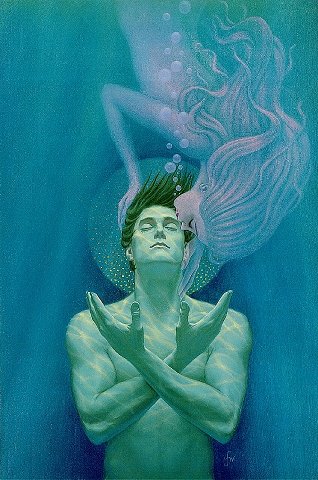The women (or girls) in these books are, for the most part, insipid, helpless creatures who are ignored, demeaned, depersonalized, objectified, or, at worst, victimized mercilessly by the male characters around them. Those who do acquire power or happiness do so through either marriage or quasi-religious devotion to a man. They tend to be one-dimensional, serving primarily as lovers, tools, or emotional supports for the main male character.

Stranger in a Strange Land (Robert A. Heinlein)
Heinlein is an easy target in this area, of course. But this book is probably the worst of the bunch. At least in The Moon Is a Harsh Mistress, the main female character has a pretty large role and motivations of her own. And in Starship Troopers, the female soldiers are pretty much equals with their male counterparts. In Stranger in a Strange Land, all of the women who are not behind-the-scenes control fiends are (a) objects of sexual pursuit by, (b) worshipful adorers of, or (c) willing servants for the male characters in the book. They are also all gorgeous, calm and soothing at all times, and often clad only in filmy robes.
One might argue that I should excuse this book, since it was
written early in the 1950s when standards were different. And, don't get me wrong, I can overlook a little old-style sexism in the interest of a good story. But there were plenty of male
writers working before women's lib came along who didn't write about women this awfully. The most sympathetically described woman in the book, Duffy Wyg&, is admiringly described as "the epitome of the modern career girl—the virgin seductress." When Duffy thinks she is being too silly, she tells her boyfriend, "punch me around a little." Another female character has a breakdown after
witnessing the murder of her father and has to be re-educated as if she
was being raised from infancy by one of the main male characters; as part of this "therapy," he pretends to her for a good long time to be her "daddy," and then, naturally, falls head over heels in love with her and seduces her, saying he loves her "mischievousness" and "urchin look." And there is no hope at all for the comparatively unsympathetically-portrayed women, who are described as flighty, superficial, gaudy, unattractive and "screeching."
The Fountains of Paradise (Arthur C. Clarke)
This book is actually a decent book with a pretty good story. And I really like most of Clarke's work; he just doesn't do all that well writing women, I don't think. He doesn't seem to be able to write them so that they seem like real people. Their conversations are stilted and they seem flat and one-dimensional. In this book, in fact, most of the female characters are literally one-dimensional: they are images of seductive, irresistibly beautiful, unattainable goddesses painted on a rock wall by a decadent, long-forgotten emperor. These paintings bewitch the various male characters to varying degrees, but seem essentially irrelevant as drivers of the plot, serving mainly as objects to admire and ponder meditatively. There is one named actual living human female character in the book, but she is used very minimally.
The Quantum Rose (Catherine Asaro)
The Quantum Rose (Catherine Asaro)
 This
book stands as evidence that female writers can also sink to the
bottom of the barrel when it comes to writing about women. Our
incredibly beautiful and intelligent Harlequin-Romance-style heroine,
Kamoj Argali, is a provincial ruler on her
planet; she is forced to get herself betrothed to a beastly but wealthy
man in
order to save her people from starvation; she then is rescued from said
awful
match by a handsome and virile stranger from another planet. Kamoj is an impossibly perfect, gorgeous, smart, kind, and generous
woman beloved simultaneously by her people and her lover; she is
purportedly strong-willed and powerful but yet she can't make up her
mind about anything and keeps getting
buffeted about by the controlling men in her life.
This
book stands as evidence that female writers can also sink to the
bottom of the barrel when it comes to writing about women. Our
incredibly beautiful and intelligent Harlequin-Romance-style heroine,
Kamoj Argali, is a provincial ruler on her
planet; she is forced to get herself betrothed to a beastly but wealthy
man in
order to save her people from starvation; she then is rescued from said
awful
match by a handsome and virile stranger from another planet. Kamoj is an impossibly perfect, gorgeous, smart, kind, and generous
woman beloved simultaneously by her people and her lover; she is
purportedly strong-willed and powerful but yet she can't make up her
mind about anything and keeps getting
buffeted about by the controlling men in her life. The Windup Girl (Paolo Bacigalupi)
And this book stands as evidence that even though a book passes the Bechdel test, it doesn't mean that its characters are necessarily strong portrayals of women. The primary female,
Emiko, is actually a robot—or, rather, a genetically-modified, semi-robotic human—built for the entertainment of men, and conditioned to obey and to serve, even at the cost of her total shame and extreme physical pain. Also, for those who have triggers in this area, the book contains two
graphic rape scenes, both involving Emiko. I know I'm not the best person to judge the necessity
of a rape scene, but these were very disturbing and seemed to me to
go on well past the point where any point about brutality had been made.
No comments:
Post a Comment